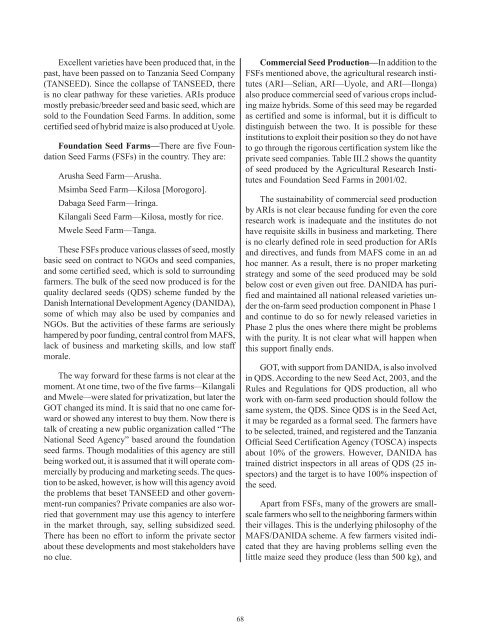An Action Plan for Developing Agricultural Input Markets in Tanzania
An Action Plan for Developing Agricultural Input Markets in Tanzania
An Action Plan for Developing Agricultural Input Markets in Tanzania
You also want an ePaper? Increase the reach of your titles
YUMPU automatically turns print PDFs into web optimized ePapers that Google loves.
Excellent varieties have been produced that, <strong>in</strong> the<br />
past, have been passed on to <strong>Tanzania</strong> Seed Company<br />
(TANSEED). S<strong>in</strong>ce the collapse of TANSEED, there<br />
is no clear pathway <strong>for</strong> these varieties. ARIs produce<br />
mostly prebasic/breeder seed and basic seed, which are<br />
sold to the Foundation Seed Farms. In addition, some<br />
certified seed of hybrid maize is also produced at Uyole.<br />
Foundation Seed Farms—There are five Foundation<br />
Seed Farms (FSFs) <strong>in</strong> the country. They are:<br />
Arusha Seed Farm—Arusha.<br />
Msimba Seed Farm—Kilosa [Morogoro].<br />
Dabaga Seed Farm—Ir<strong>in</strong>ga.<br />
Kilangali Seed Farm—Kilosa, mostly <strong>for</strong> rice.<br />
Mwele Seed Farm—Tanga.<br />
These FSFs produce various classes of seed, mostly<br />
basic seed on contract to NGOs and seed companies,<br />
and some certified seed, which is sold to surround<strong>in</strong>g<br />
farmers. The bulk of the seed now produced is <strong>for</strong> the<br />
quality declared seeds (QDS) scheme funded by the<br />
Danish International Development Agency (DANIDA),<br />
some of which may also be used by companies and<br />
NGOs. But the activities of these farms are seriously<br />
hampered by poor fund<strong>in</strong>g, central control from MAFS,<br />
lack of bus<strong>in</strong>ess and market<strong>in</strong>g skills, and low staff<br />
morale.<br />
The way <strong>for</strong>ward <strong>for</strong> these farms is not clear at the<br />
moment. At one time, two of the five farms—Kilangali<br />
and Mwele—were slated <strong>for</strong> privatization, but later the<br />
GOT changed its m<strong>in</strong>d. It is said that no one came <strong>for</strong>ward<br />
or showed any <strong>in</strong>terest to buy them. Now there is<br />
talk of creat<strong>in</strong>g a new public organization called “The<br />
National Seed Agency” based around the foundation<br />
seed farms. Though modalities of this agency are still<br />
be<strong>in</strong>g worked out, it is assumed that it will operate commercially<br />
by produc<strong>in</strong>g and market<strong>in</strong>g seeds. The question<br />
to be asked, however, is how will this agency avoid<br />
the problems that beset TANSEED and other government-run<br />
companies? Private companies are also worried<br />
that government may use this agency to <strong>in</strong>terfere<br />
<strong>in</strong> the market through, say, sell<strong>in</strong>g subsidized seed.<br />
There has been no ef<strong>for</strong>t to <strong>in</strong><strong>for</strong>m the private sector<br />
about these developments and most stakeholders have<br />
no clue.<br />
68<br />
Commercial Seed Production—In addition to the<br />
FSFs mentioned above, the agricultural research <strong>in</strong>stitutes<br />
(ARI—Selian, ARI—Uyole, and ARI—Ilonga)<br />
also produce commercial seed of various crops <strong>in</strong>clud<strong>in</strong>g<br />
maize hybrids. Some of this seed may be regarded<br />
as certified and some is <strong>in</strong><strong>for</strong>mal, but it is difficult to<br />
dist<strong>in</strong>guish between the two. It is possible <strong>for</strong> these<br />
<strong>in</strong>stitutions to exploit their position so they do not have<br />
to go through the rigorous certification system like the<br />
private seed companies. Table III.2 shows the quantity<br />
of seed produced by the <strong>Agricultural</strong> Research Institutes<br />
and Foundation Seed Farms <strong>in</strong> 2001/02.<br />
The susta<strong>in</strong>ability of commercial seed production<br />
by ARIs is not clear because fund<strong>in</strong>g <strong>for</strong> even the core<br />
research work is <strong>in</strong>adequate and the <strong>in</strong>stitutes do not<br />
have requisite skills <strong>in</strong> bus<strong>in</strong>ess and market<strong>in</strong>g. There<br />
is no clearly def<strong>in</strong>ed role <strong>in</strong> seed production <strong>for</strong> ARIs<br />
and directives, and funds from MAFS come <strong>in</strong> an ad<br />
hoc manner. As a result, there is no proper market<strong>in</strong>g<br />
strategy and some of the seed produced may be sold<br />
below cost or even given out free. DANIDA has purified<br />
and ma<strong>in</strong>ta<strong>in</strong>ed all national released varieties under<br />
the on-farm seed production component <strong>in</strong> Phase 1<br />
and cont<strong>in</strong>ue to do so <strong>for</strong> newly released varieties <strong>in</strong><br />
Phase 2 plus the ones where there might be problems<br />
with the purity. It is not clear what will happen when<br />
this support f<strong>in</strong>ally ends.<br />
GOT, with support from DANIDA, is also <strong>in</strong>volved<br />
<strong>in</strong> QDS. Accord<strong>in</strong>g to the new Seed Act, 2003, and the<br />
Rules and Regulations <strong>for</strong> QDS production, all who<br />
work with on-farm seed production should follow the<br />
same system, the QDS. S<strong>in</strong>ce QDS is <strong>in</strong> the Seed Act,<br />
it may be regarded as a <strong>for</strong>mal seed. The farmers have<br />
to be selected, tra<strong>in</strong>ed, and registered and the <strong>Tanzania</strong><br />
Official Seed Certification Agency (TOSCA) <strong>in</strong>spects<br />
about 10% of the growers. However, DANIDA has<br />
tra<strong>in</strong>ed district <strong>in</strong>spectors <strong>in</strong> all areas of QDS (25 <strong>in</strong>spectors)<br />
and the target is to have 100% <strong>in</strong>spection of<br />
the seed.<br />
Apart from FSFs, many of the growers are smallscale<br />
farmers who sell to the neighbor<strong>in</strong>g farmers with<strong>in</strong><br />
their villages. This is the underly<strong>in</strong>g philosophy of the<br />
MAFS/DANIDA scheme. A few farmers visited <strong>in</strong>dicated<br />
that they are hav<strong>in</strong>g problems sell<strong>in</strong>g even the<br />
little maize seed they produce (less than 500 kg), and

















